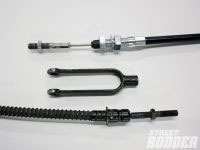1940 Ford E-Brake - Easy E-Brake Leveraging any hand operated brake assembly
Posted by Kyle Madsen on 23rd Mar 2014
Here is an article I found and would like to share with our readers.
Street Rodder, July 01, 2010 By Jay Storer

Like most of our readers, we have utilized various hand-operated parking brake mechanisms in street rods over the years. Several Deuces were fitted with classic '40 Ford underdash units tucked up close to the driver's kick panel, and a few cars with Pinto/Vega-style hand brakes that mounted closely to the floor, next to the shifter. The '40 piece has its historic appeal and keeps the floor less cluttered, although it does take some adaptation in pre-fat fender installations. The low-profile, floor-mounted units, aftermarket or wrecking yard, are inexpensive and easy to install on a tunnel or a flat floor, but most have short handles that dictate that you use more "armstrong" power. This can be a drawback if your better half has to yank hard to release the e-brake. You will hear about that.
This installation is in a '40 pickup, but the basic ingredients can be applied to almost any make or model. We have a typical 9-inch Ford rearend and we retained the stock parking brake cable loop that was on it. The 112-inch wheelbase on a '40 pickup is long enough to allow using the full length of the cable loop, which is good because the cutting and splicing that comes with shortening these OEM cables can get ugly; it usually starts with some cursing and ends with antiseptic and bandages.
We made a small crossmember of 1x1 steel tubing that would function as a driveshaft safety device (although not for legal racing) and mounted it to the rear legs of our X-member at a point that would make easy mounting of the rear parking brake cable housing ends.
Now we had the forward location of the center of the brake cable loop, and could measure the approximate length of the front brake cable we needed, plus find a good location for the rear of the front brake cable to be secured. We had an original 1940 Ford e-brake cable, but decided against using it. In Henry's overbuilt design the steel wire-wrapped outer cable housing, though bulletproof, doesn't lend itself to making bends to snake around typical hot rod additions, like big exhaust pipes bulky TH400 transmissions, and an OHV engine stuffed right up against the firewall.
A modern cable would be the answer, both for flexibility in routing and because you can order exactly the length and end mounts you need. Our experience with previous rods and a Bonneville car told us we needed only make one call: to Control Cables. Our gennie cable was much too long for our application. This is a perfect time to rephrase a

popular expression, "Measure twice, order once!" Another stray thought that occurred to us was a means to increase the application power of the hand brake. As we remember from history, the ancient peoples built their amazing monuments of stone by applying the basic physics of leverage. Instead of lifting a bolder by hand, they learned they could stick a long prytool under it, put a log under it and push down (probably a bunch of guys pushing down). We remembered some cars of the '50s and '60s that had a "leverage bar" that was attached at one end to the chassis, and the other end was pulled by the front e-brake cable.
Not having any luck finding one of these at a swap meet or wrecking yard, we used a length of 1-inch-wide, 1/4-inch-thick steel strap. One end was mounted to the bottom flange of the right rear leg of the '40 X-member. The spot to mount it was arrived at by attaching a front hoop to our Ford rear cable loop, inserting a 4-inch-long bolt as an adjuster, and seeing how far forward we wound up. With the right end of the bar mounted, we could now measure from the left end of the bar (with the bar basically at 90 degrees to the truck's centerline). Our X-member had been gutted and reinforced with a Chassis Engineering kit, which includes a rear stiffener plate that gave us a flat area to mount the rearend of our brake cable.
Measuring several times, we determined that from the hand-brake pivot down through the chassis and to that plate, we needed a 65-inch cable, and the rearend of it needed 4 inches of travel. Our other parameter was the type of threads we wanted. With a 5/16-inch fine thread we could utilize the original '40 yoke that attaches to the e-brake assembly. You could probably order a cable such as ours from some order taker at an industrial supply place somewhere, but the friendly guys at Control Cables deal with hot rodders and racers daily, and they make it easy. We ordered the cable, and a week later we had it exactly as desired, and for only $35.60, which is less than an early Ford outer cable and a repro inner cable and much easier to use. The new cable looks good, bends easily, and works silky-smooth. The price will vary somewhat depending on length and your other requirements.
The leverage of an e-brake bar such as this depends entirely on where along the bar you mount the hookup to the rear cables, whether you have a loop cable like ours or two cables mounted to an equalizer bar. The closer to the pivot point, the more leverage, but travel lessens. Drill several holes in the bar and you can select the best feel for your needs.

